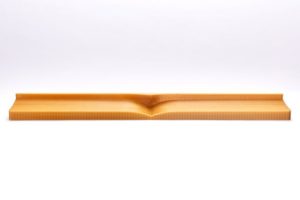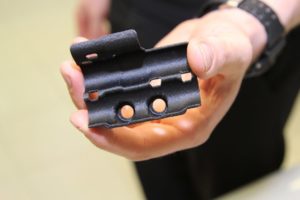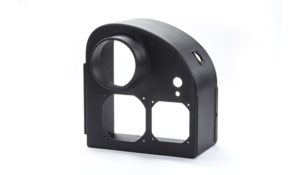Stratasys at the Grand Prix: McLaren Formula 1 Races Ahead with 3D Printed Parts and Trackside 3D Printing
 Now that March Madness is over, we can all turn our eyes from the court to the track, as the Grand Prix kicks off later this month. In the fast-paced, high stakes world of Formula 1 racing, accuracy and precision are key…and what offers more precision than 3D printing? In January, leading 3D printer manufacturer Stratasys signed a four-year partnership with McLaren Racing, as its official 3D printing solutions provider. While McLaren’s Formula 1 cars have won over 180 Grands Prix, McLaren Applied Technologies works out strategic business partnerships that channel its design and simulation system expertise, and also develops and builds control units for the Indy Car, NASCAR, and Formula 1 grids, which is where the partnership with Stratasys comes in.
Now that March Madness is over, we can all turn our eyes from the court to the track, as the Grand Prix kicks off later this month. In the fast-paced, high stakes world of Formula 1 racing, accuracy and precision are key…and what offers more precision than 3D printing? In January, leading 3D printer manufacturer Stratasys signed a four-year partnership with McLaren Racing, as its official 3D printing solutions provider. While McLaren’s Formula 1 cars have won over 180 Grands Prix, McLaren Applied Technologies works out strategic business partnerships that channel its design and simulation system expertise, and also develops and builds control units for the Indy Car, NASCAR, and Formula 1 grids, which is where the partnership with Stratasys comes in.
 This week, the two are announcing another deal – McLaren is expanding its current use of Stratasys’ FDM 3D printers, and will be racing its 2017 Formula 1 MCL32 race car, which now features 3D printed parts, at the Grand Prix. In order to increase performance through weight reduction, and accelerate design modifications, some of McLaren’s most important, heat-sensitive parts are being manufactured on Stratasys 3D printers.
This week, the two are announcing another deal – McLaren is expanding its current use of Stratasys’ FDM 3D printers, and will be racing its 2017 Formula 1 MCL32 race car, which now features 3D printed parts, at the Grand Prix. In order to increase performance through weight reduction, and accelerate design modifications, some of McLaren’s most important, heat-sensitive parts are being manufactured on Stratasys 3D printers.
“The ability to rapidly model, build and evaluate new components is an invaluable asset for any fast-moving and dynamic racing organisation,” Eric Boullier, Racing Director of McLaren Racing, told 3DPrint.com. “It has become clear that motorsport’s reliance on rapid prototyping and additive manufacturing, and the ability to radically cut time to market, is increasing. Our partnership with Stratasys will not only increase our output in that area, but also allow us to dynamically explore and utilise the cutting-edge of Stratasys’ new 3D printing innovations and solutions.”

Circuit de Barcelona Catalunya, Barcelona, Spain. March 8, 2017. Fernando Alonso, McLaren MCL32 Honda. [Image: Stratasys]
- Rear Wing Flap: this large extension, designed to increase rear downforce, was manufactured in carbon fiber-reinforced composites, with the help of a lay-up tool that was 3D printed on the Fortus 900mc Production 3D printer. The high-temperature, 900mm-wide autoclave-cured composite structure was 3D printed, using ULTEM 1010 material, in three days during the limited testing period.
- Hydraulic Line Bracket: this structural bracket, which attaches to the car’s hydraulic line, was 3D printed on the Fortus 450mc Production 3D printer. While it normally takes two weeks to manufacture with conventional methods, the bracket was 3D printed in just four hours, using carbon fiber-reinforced nylon material.
- Carbon Fiber Brake Cooling Ducts: sacrificial tools were 3D printed to make hollow composite brake cooling ducts, in order to efficiently control brake component temperatures. The wash-out cores were 3D printed with ST-130 soluble material, which was specially developed for this application, then wrapped with carbon fiber-reinforced composite material, and autoclave-cured at high temperatures. The resulting tubular structure has a smooth internal surface finish, which helps maintain the highest level of car and aerodynamic performance by making sure the necessary airflow gets to the brakes.
- Flexible Radio Harness Location Boot: this rubber-like boot joins the harness wires of the MCL32 race car’s new two-way communication and data system, as the first cable distracted the driver too much. Three different designs of the boot were iterated and 3D printed in one day, and the final design was printed on the J750 3D printer, using flexible materials, in just two hours. This quick fix meant that the radio harness assembly was able to be utilized in the first Grand Prix race this season.
- Composite layup tool for a McLaren MCL32 rear wing flap, produced on a Stratasys Fortus 900mc 3D Printer using ULTEM 1010 material
- Hydraulic line bracket for the McLaren MCL32 race car, 3D printed on a Stratasys FDM 3D Printer using Nylon12CF material
- Cooling fan duct mounting for the McLaren MCL21 race car, used during pit stop testing, produced on a Stratasys FDM 3D Printer using ABS material
- Radio harness for the McLaren MCL32 race car, produced on a PolyJet-based Stratasys J750 3D Printer using rubber-like material
What I find really interesting is that the McLaren racing team will actually have Stratasys uPrint SE Plus 3D printers to the track on race days, for on-demand production of jigs and pieces. This will allow the parts to be evaluated immediately during track tests, and races.
“We are consistently modifying and improving our Formula 1 car designs, so the ability to test new designs quickly is critical to making the car lighter and more importantly increasing the number of tangible iterations in improved car performance. If we can bring new developments to the car one race earlier – going from new idea to new part in only a few days – this will be a key factor in making the McLaren MCL32 more competitive,” said Neil Oatley, Design and Development Director, McLaren Racing. “By expanding the use of Stratasys 3D printing in our manufacturing processes, including producing final car components, composite lay-up and sacrificial tools, cutting jigs, and more, we are decreasing our lead times while increasing part complexity.”

Albert Park, Melbourne, Australia.Sunday 26 March 2017.Fernando Alonso, McLaren, on the grid. [Image: Stratasys]
“Formula 1 is one of the world’s best proving grounds for our additive manufacturing solutions,” said Andy Middleton, President, Stratasys EMEA. “As the Official Supplier of 3D Printing Solutions to the McLaren-Honda Formula 1 team, we are working closely together to solve their engineering challenges in the workshop, in the wind-tunnel, and on the track. We believe that this, in turn, will enable us to develop new materials and applications that bring new efficiencies and capabilities to McLaren Racing and other automotive designers and manufacturers.”
Discuss in the Stratasys forum at 3DPB.com.
Subscribe to Our Email Newsletter
Stay up-to-date on all the latest news from the 3D printing industry and receive information and offers from third party vendors.
You May Also Like
Precision at the Microscale: UK Researchers Advance Medical Devices with BMF’s 3D Printing Tech
University of Nottingham researchers are using Boston Micro Fabrication‘s (BMF) 3D printing technology to develop medical devices that improve compatibility with human tissue. Funded by a UK grant, this project...
3D Printing Webinar and Event Roundup: April 21, 2024
It’s another busy week of webinars and events, starting with Hannover Messe in Germany and continuing with Metalcasting Congress, Chinaplas, TechBlick’s Innovation Festival, and more. Stratasys continues its advanced training...
3D Printing Webinar and Event Roundup: March 17, 2024
It’s another busy week of webinars and events, including SALMED 2024 and AM Forum in Berlin. Stratasys continues its in-person training and is offering two webinars, ASTM is holding a...
3D Printed Micro Antenna is 15% Smaller and 6X Lighter
Horizon Microtechnologies has achieved success in creating a high-frequency D-Band horn antenna through micro 3D printing. However, this achievement did not rely solely on 3D printing; it involved a combination...

































